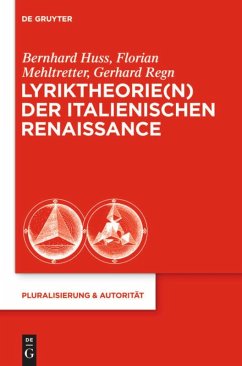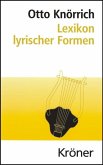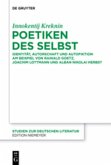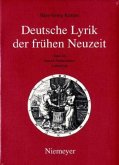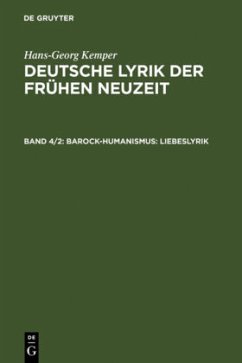This volume deals with different attempts undertaken during the Italian Renaissance to define the nature of the â??lyricalâ? and of individual lyrical forms (including sonnets, epigrams, canzone, ballads, madrigals, and elegies). It begins with an introductory outline of the fundamental dilemma of the era, when an attempt was made to transform the diverse traditions of lyrical writing and the various theoretical options in the literary theory of the cinquecento into a coherent system of poetics. Subsequently, the first main chapter details the different systematic approaches, influenced predominantly by a reading of Aristotelian poetics, attempted by G.G. Trissino, I.C. Scaliger, A.S. Minturno, P. Torellis, and T. Tasso. The second main chapter provides an extensive analysis of contemporary theories about the specific lyrical forms listed above. Overall, this study reveals that lyrical theory in the cinquecento remained a precarious territory: a unitary theory of poetics does not emerge, but instead, we must accept a plurality of possible proposals for a lyrical theory.
Das italienische Cinquecento gilt als das Jahrhundert, in dem die europäische Literaturtheorie der Neuzeit 'geboren wurde'. Die ausführliche zeitgenössische Diskussion um einzelne Gattungen (wie Epos, Tragödie, Komödie), die im Horizont eines Gegensatzes von rhetorisch perspektivierter Stillagenpoetik und aufkommendem poetologischem Aristotelismus steht, belegt dies. Besonders problematisch stellt sich der Renaissance die Theoretisierung einer einheitlichen Gattung 'Lyrik' dar: Einerseits ist die Aufgabe einer Definition von 'Lyrik' angesichts der volkssprachlichen Dichtungspraxis, in der der lyrische Petrarkismus eine Hauptströmung ist, unabweisbar dringend. Andererseits stellen die disponiblen theoretischen Optionen nur sehr fragmentarische Werkzeuge zur Bewältigung dieser Aufgabe bereit. Vor diesem Hintergrund behandelt der Band zunächst die grundsätzliche, epochentypische Problematik, konkrete lyrische Praxis und theorieoptionale Vielfalt im Rahmen einer schlüssigen Gattungstheorie in Einklang zu bringen. Danach werden die wichtigsten lyriktheoretischen Schriften (von G.G. Trissino, J.C. Scaliger, A.S. Minturno, P. Torelli und T. Tasso) ausführlich analysiert und im Anschluss die rinascimentalen Diskussionen um die wichtigsten lyrischen Einzelformen (wie Sonett, Canzone, Madrigal und Ballata) kritisch untersucht. Es erweist sich, dass die Bemühung um eine kohärente Lyriktheorie in der Renaissance prekär bleibt: Das Cinquecento zeitigt ungeachtet seiner heftigen Systematisierungsbestrebungen eine Theorie der Lyrik 'im Plural'.
Das italienische Cinquecento gilt als das Jahrhundert, in dem die europäische Literaturtheorie der Neuzeit 'geboren wurde'. Die ausführliche zeitgenössische Diskussion um einzelne Gattungen (wie Epos, Tragödie, Komödie), die im Horizont eines Gegensatzes von rhetorisch perspektivierter Stillagenpoetik und aufkommendem poetologischem Aristotelismus steht, belegt dies. Besonders problematisch stellt sich der Renaissance die Theoretisierung einer einheitlichen Gattung 'Lyrik' dar: Einerseits ist die Aufgabe einer Definition von 'Lyrik' angesichts der volkssprachlichen Dichtungspraxis, in der der lyrische Petrarkismus eine Hauptströmung ist, unabweisbar dringend. Andererseits stellen die disponiblen theoretischen Optionen nur sehr fragmentarische Werkzeuge zur Bewältigung dieser Aufgabe bereit. Vor diesem Hintergrund behandelt der Band zunächst die grundsätzliche, epochentypische Problematik, konkrete lyrische Praxis und theorieoptionale Vielfalt im Rahmen einer schlüssigen Gattungstheorie in Einklang zu bringen. Danach werden die wichtigsten lyriktheoretischen Schriften (von G.G. Trissino, J.C. Scaliger, A.S. Minturno, P. Torelli und T. Tasso) ausführlich analysiert und im Anschluss die rinascimentalen Diskussionen um die wichtigsten lyrischen Einzelformen (wie Sonett, Canzone, Madrigal und Ballata) kritisch untersucht. Es erweist sich, dass die Bemühung um eine kohärente Lyriktheorie in der Renaissance prekär bleibt: Das Cinquecento zeitigt ungeachtet seiner heftigen Systematisierungsbestrebungen eine Theorie der Lyrik 'im Plural'.

